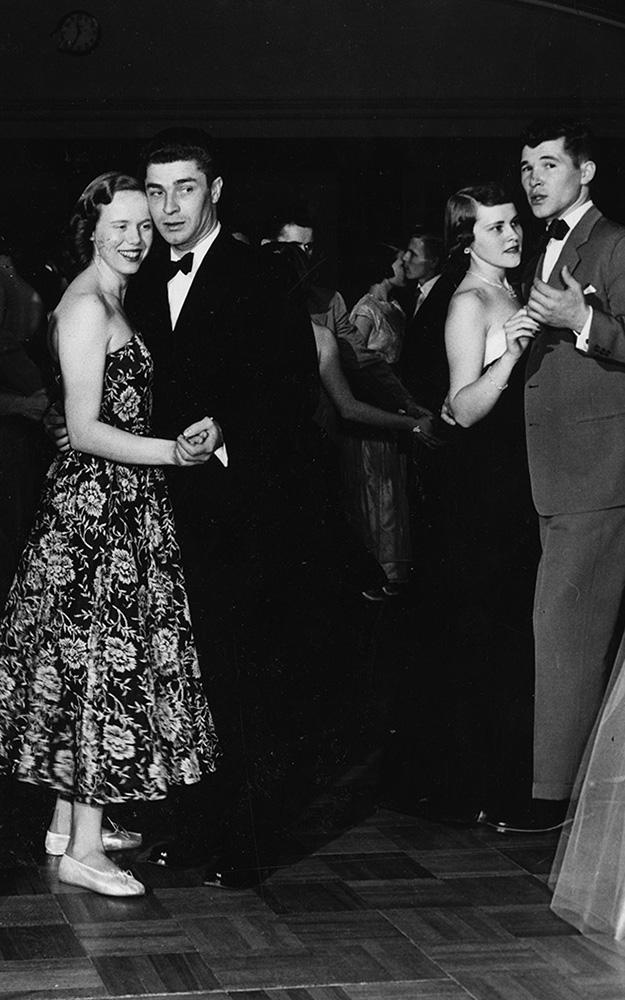Different Rules for Living and Social Activities
 |
| Central students at a dance, circa 1950 From the CMU Photographic Veritcal File |
From the first moments in CMU's history, women and men were treated differently. Differentiated curricular offerings existed from the start and lasted into the 1970s. Coaches, athletes, and administrators continue to fight for equality in college sports even as we move well into the twenty-first century. From the outset, women were governed by restrictions in their student life and social activities.
Arguably one of the most important aspects of the college and university experience is student life outside of the classroom. Clubs, dances, Homecoming, student government, residence hall associations, and a multitude of other opportunities offer students a chance to meet people, form bonds, and learn how to navigate the world. Into the 1970s, the institution's faculty and administration played a large part in student activities.
Prior to on-campus living, Central students lived at home with their families, in Mt. Pleasant rooming houses, or in other off-campus accommodations. In 1924, Central opened Ronan Hall, the first residence hall for on-campus living (not the current Ronan Hall, but a residence hall that was demolished in 1970). Ronan Hall was for women only and housed approximately 160 women. It was 15 years later before the first residence hall for men opened, when the Keeler Union offered 90 beds for male students beginning in 1939.
After WWII, the number of students living in on-campus housing skyrocketed at Central. Married student housing, known as Vetville, was built in 1946 and allowed mixed-sex living for married students, many of whom enrolled at Central using GI Bill benefits. More residence halls for women and men were constructed: Barnard Hall (1948), Barnes Hall (1951), Tate Hall (1956), Preston Court (1954) and Washington Court apartments for married students (1956), and the north residence hall quad of Calkins, Larzelere, Robinson, and Trout Halls (1954-59).
 |
| Page from CMU student handbook, 1956 |
With the increase in on-campus accommodations came an increase in rules. At this time, like other colleges and universities across the country, Central governed students by the policy of in loco parentis—in place of students' parents, the institution would make decisions regarding students' lives, acting as what would be considered a "typical" parent at the time. The policy of in loco parentis meant that Central enforced curfews, restrictions on the mixing of the sexes in residence halls, and limits on parties and social activities.
The 1956 Central Michigan College handbook for students gives a glimpse of the rules that existed for students:
- Students were not permitted to have members of the opposite sex in their rooms at any time except during periods of "open house."
- Unmarried students living in off-campus suites or apartments were not permitted to have members of the opposite sex in the residence at any time.
- Men were not required to keep hours. Women were to be in their living quarters by 10:30 pm, Monday through Thursday, by midnight Friday, by 1:00 am Sunday morning and by 11:00 pm Sunday evening.
- All women students were to sign out and sign in at their residence during evenings.
- Unmarried students under 21 years of age were not permitted to live in quarters that had a private entrance.
Throughout the 1960s, students demanded liberalization of housing regulations and an end to in loco parentis. In 1968, in response to demands from students and changing mores across the United States, CMU abolished a policy of in loco parentis. But differentiated hours for women students still persisted, albeit in a slightly relaxed form. For instance, in 1968, women's hours were 2:00 am on the weekends unless the woman was 21 years old or had 55 credits and "a properly signed 'Parental Permission Card for Special Women's Hours.'" Ten years prior, women had to be in by 1:00 am on the weekends regardless of their age or standing.
As the 1960s turned to the 1970s, CMU continued liberalizing residence halls and social rules. Co-educational living was a big step. The first residence hall that allowed women and men to live on the same floor was Barnes Hall, beginning in 1971. Of course, it came with restrictions—students had to be 21 years old or have at least 55 credits and parental permission.
The second big step was the end of differentiated curfews in 1972. As Dee Boersma, a leader in student government and member of the Board of Trustees beginning in 1970, said in a 2014 Centralight profile, "Finally, both men and women were treated the same and one sex didn't have to be in their dorm halls by 11 p.m. while the opposite sex did not. It was a small move forward, but a meaningful one."
Co-educational living, without differentiated curfews, increased across the CMU campus over the next 40 years. In 2010, Sweeney Hall was the last hall to switch from single-sex to co-ed when it switched from a women-only residence hall.
